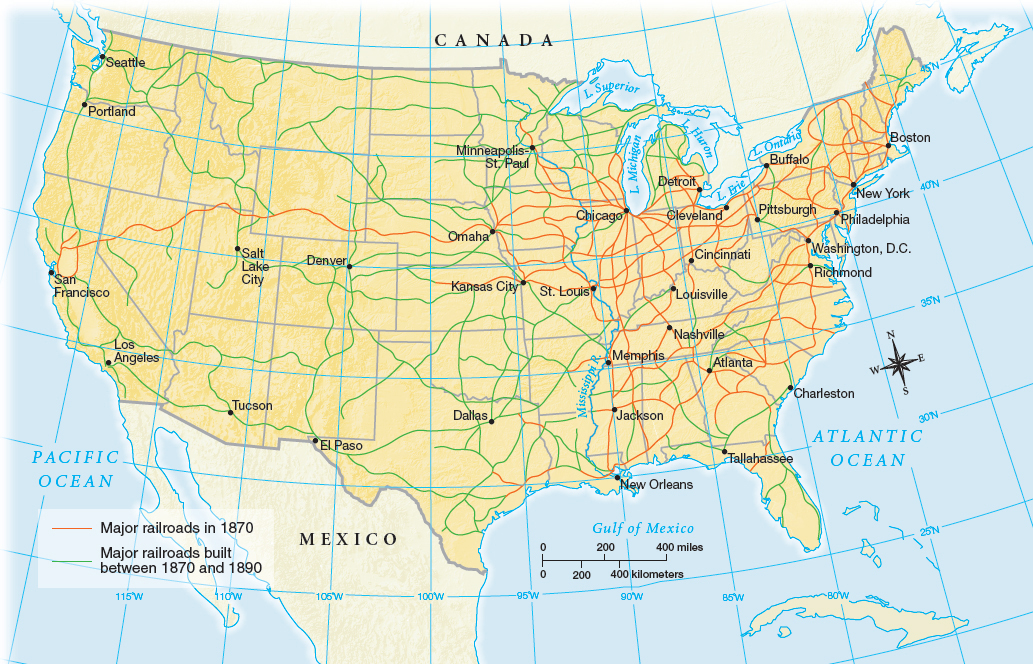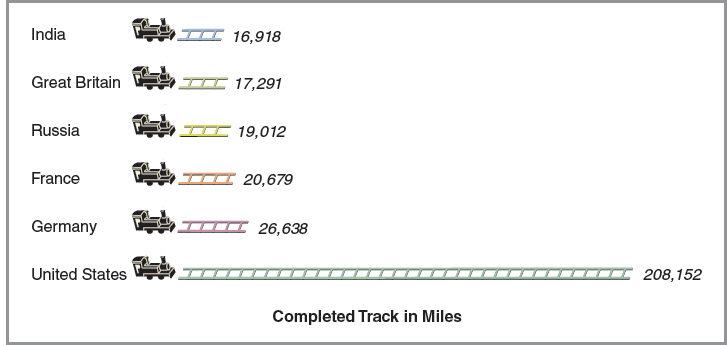Railroads: America’s First Big Business
Printed Page 519
Section Chronology
The military conquest of America’s inland empire and the dispossession of Native Americans (see chapter 17) were fed by an elaborate new railroad system built on speculation and government giveaways. Between 1870 and 1880, overbuilding doubled the amount of track in the country; in the following decade, the nation’s railroad mileage nearly doubled again. By 1900, the nation boasted more than 193,000 miles of railroad track — more than in all of Europe and Russia combined (Map 18.1 and Figure 18.1). Privately owned but publicly financed by enormous land grants from the federal government and the states, the railroads epitomized the insidious nexus of business and politics in the Gilded Age.

To understand how the railroads came to dominate American life, there is no better place to start than with the career of Jay Gould, the era’s most notorious speculator. Jason “Jay” Gould bought his first railroad before he turned twenty-five. It was only sixty-two miles long, in bad repair, and on the brink of failure, but within two years he sold it at a profit of $130,000.
The secretive Gould operated in the stock market like a shark, looking for vulnerable railroads, buying enough stock to take control, and threatening to undercut his competitors until they bought him out at a high profit. The railroads that fell into his hands fared badly and often went bankrupt. Gould’s genius lay not in providing transportation, but in cleverly buying and selling railroad stock on Wall Street. Millionaires like Gould adopted the strategy of expansion and consolidation, which in turn encouraged overbuilding of the railroads and stimulated a national market.


The New York Stock Exchange expanded as the volume of stock increased sixfold between 1869 and 1901. As the scale and complexity of the financial system increased, the line between investment and speculation blurred, causing many Americans to question if speculators manipulating paper profits fueled the boom and bust cycles that led to panic and depression, putting hardworking Americans out of jobs.
The dramatic growth of the railroads created the country’s first big business. Before the Civil War, even the largest textile mill in New England employed no more than 800 workers. By contrast, the Pennsylvania Railroad by the 1870s boasted a payroll of more than 55,000 workers. Capitalized at more than $400 million, the Pennsylvania Railroad constituted the largest private enterprise in the world.
The big business of railroads bestowed enormous riches on a handful of tycoons. Both Gould and his competitor “Commodore” Cornelius Vanderbilt amassed fortunes estimated at $100 million. Such staggering wealth eclipsed that of upper-class Americans from previous generations and left a legacy of lavish spending for an elite crop of ultra-rich heirs.
The Republican Party, firmly entrenched in Washington, worked closely with business interests, subsidizing the transcontinental railroad system with land grants of a staggering 100 million acres of public land and $64 million in tax incentives and direct aid. States and local communities joined the railroad boom, knowing that only those towns and villages along the tracks would grow and flourish.
CHAPTER LOCATOR
How did the railroads stimulate big business?
Why did the ideas of social Darwinism appeal to many Americans in the late nineteenth century?
What factors influenced political life in the late nineteenth century?
What issues shaped party politics in the late nineteenth century?
What role did economic issues play in party realignment?
Conclusion: Why did business dominate the Gilded Age?
 LearningCurve
LearningCurve
Check what you know.
A revolution in communication accompanied and supported the growth of the railroads. The telegraph, developed by Samuel F. B. Morse, marched across the continent alongside the railroad. By transmitting coded messages along electrical wire, the telegraph formed the “nervous system” of the new industrial order. Telegraph service quickly replaced Pony Express mail carriers in the West and transformed business by providing instantaneous communication. Again, Jay Gould took the lead. In 1879, through stock manipulation, he seized control of Western Union, the company that monopolized the telegraph industry.
The railroads soon fell on hard times. Already by the 1870s, lack of planning led to overbuilding. Across the nation, railroads competed fiercely for business. A manufacturer in an area served by competing railroads could get substantially reduced shipping rates in return for promises of steady business. Because railroad owners lost money through this kind of competition, they tried to set up agreements, or “pools,” to divide up territory and set rates. But these informal gentlemen’s agreements invariably failed because men like Jay Gould, intent on undercutting all competitors, refused to play by the rules.
The public’s alarm at the control wielded by the new railroad magnates and the tactics they employed provided a barometer of attitudes toward big business itself. When Gould died in 1892, he was, as he himself admitted, “the most hated man in America.“